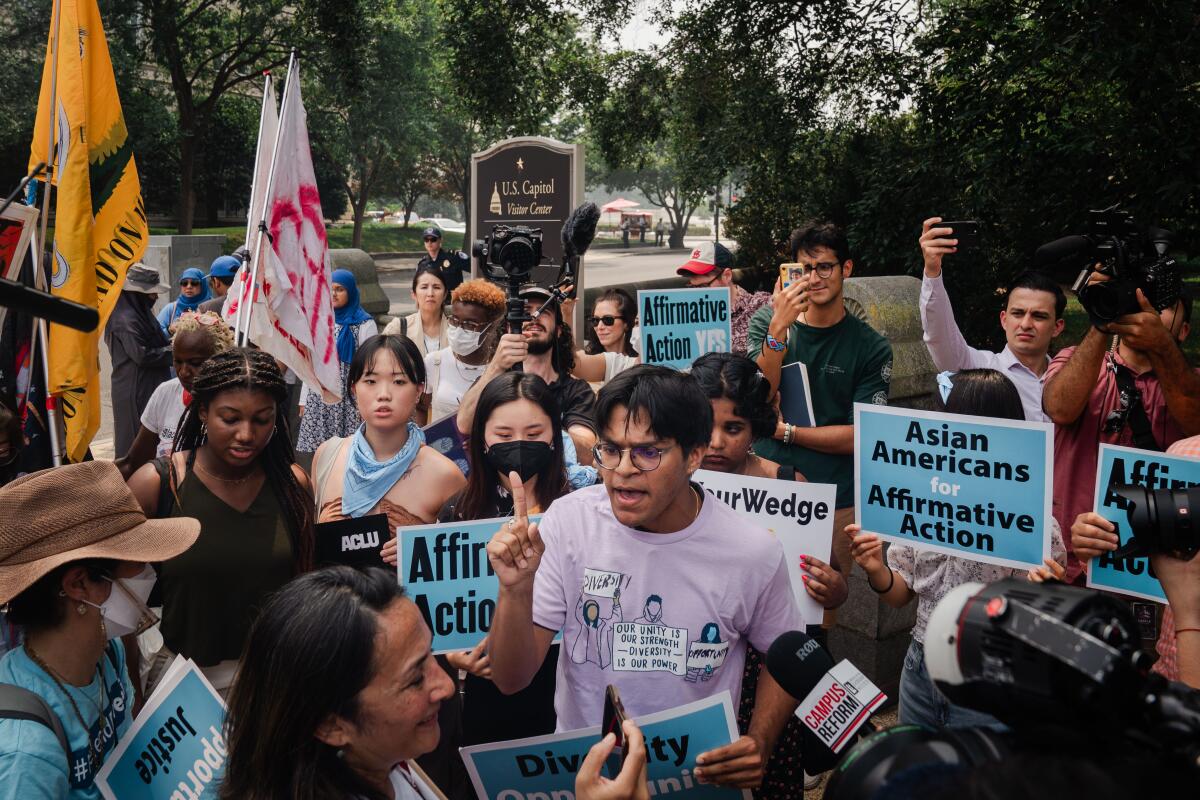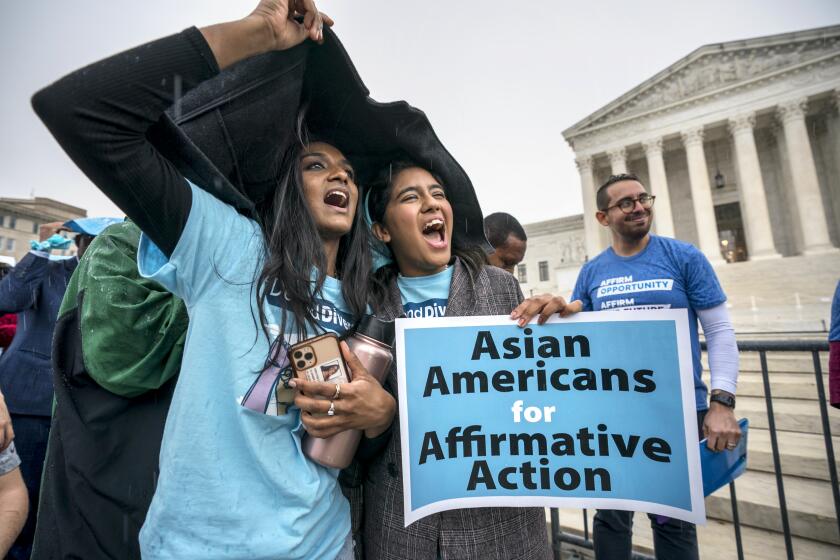Affirmative action ruling demands earlier intervention for equal college access

- Share via
A few weeks before the Supreme Court ruled that race-based college admission policies were unconstitutional, Florida native Jon Wang claimed on Fox Nation that he was rejected from MIT, Caltech, UC Berkeley and other elite colleges because of affirmative action. His SAT score was 1590 and his GPA was 4.65. Social media buzzed with sympathy, with many claiming that Wang’s rejections were proof of the need to ban affirmative action.
I bristled at Wang’s reasoning, but did sympathize with his disappointment. My son and his friends — all among the top 15 students in their senior class of about 750 — had also received unwelcome news from exclusive colleges in the spring. Most are Asian and my son is Latino. All had GPAs ranging from 4.8 to 4.9, earned in the rigorous International Baccalaureate program, and a well-rounded list of extracurricular activities that included sports, leadership and awards.
Wang was among countless other qualified students, not all of them Asian or white, rejected from dream colleges. That doesn’t make him a poster child for the anti-affirmative action movement so much as a typical applicant.
Getting into a top college these days is difficult, even for well-qualified students. Many top schools accept less than 10% of applicants. Applying to college in such competitive times means the effects of the Supreme Court’s affirmative action ruling probably will be severe. If my son and his friends faced difficult odds before the ruling, what will admission rates be like when my daughter applies to colleges next year? What will they be for students from less privileged backgrounds?
Editorial: Supreme Court’s affirmative action ban is a catastrophic blow to the American dream
If they truly want a diverse student body, colleges and universities must eliminate all other preferential admissions policies, especially for legacy applicants.
The only way to counterbalance this dreadful ruling is to ensure students from underrepresented communities have the same educational opportunities much earlier. For now, it’s urgent that colleges abandon legacy and other admission policies that favor white and wealthy students. It’s encouraging that’s starting to happen.
In July, the U.S. Department of Education’s Office for Civil Rights opened an investigation into whether Harvard University discriminates on the basis of race and ethnicity in its legacy and donor policies. Also in July, Wesleyan University joined other selective colleges in ending legacy admissions, which favor students whose relatives are alumni or donors, and tend to be white.
In a blog post explaining the decision, Wesleyan president Michael S. Roth outlined a robust approach the university is taking to ensure a diverse student body. This includes bolstering outreach to community groups, college access programs, community colleges and Title I high schools, which are high schools with higher percentages of lower-income students. Increasing financial aid is a key aspect of the multi-pronged plan to recruit students from more diverse backgrounds.
Opponents of affirmative action argue that simply eliminating it will automatically create a level playing field for all students. It won’t.
This is a welcome approach, but ensuring that students have equitable access to the most elite colleges in the United States needs to start much sooner. Affirmative action was a response to the fact that many people face a multitude of inequities throughout their lives, often perpetuated by historical systemic racism such as redlining that impedes wealth accumulation and health.
The race toward college really begins at birth, with research showing that parents who speak more words to their babies spur brain development that leads to better language skills. Imagine how many more words college-educated, stay-at-home parents are able to speak with their babies than immigrant parents working six days a week.
The gap only widens as time marches on. Many believe that students who do not read at grade level by third grade are more likely to drop out of high school. Such dire forecasts play out in various ways. Some students are shuttled toward remedial classes, while those on the other end of the academic spectrum are tested for gifted classes. Such testing should include all students regardless of their academic performance, but often teacher referrals are the decisive factor. There has been a lot of controversy over who is selected for testing and who enrolls in these classes because these higher-level, fast-paced classes often help shape future valedictorians and other high-achievers. In California, enrollment in gifted and talented education (GATE) classes is 11.6% Asian, 7.1% white, 4.7% Latino and 3.5% Black students.
Now that affirmative action is banned, the way to level the field is one Black student at a time
Even without the burden of ‘colorblind’ admissions policies, equalizing opportunities for South L.A. students required their perseverance and intensive support.
In my kids’ school district, the students in gifted classes usually choose to continue high-level studies by enrolling in the IB program in middle and high school. My son’s high school is 62% Latino in a student population of 3,000, yet he was just one of three Latinos in the graduating class of about 30 IB students. Of course, my son, a former GATE student, is smart, hardworking and ambitious. But I certainly do not think he’s the only Latino student with these qualities.
After the hardships I endured in my childhood as a low-income immigrant, I have worked hard to ensure my kids have the support and guidance they need throughout their schooling. I knew it would be more difficult for them to gain admission to college at a time when there are more applicants than ever at elite colleges, though I never would have anticipated how competitive this process would be. Even my alma mater, USC, has gone from a 69% admittance rate in the 1980s to 9.9% in 2023.
Such odds make it difficult not just for the Jon Wangs of the world, but also and especially underprivileged students. With affirmative action policies gone, universities must get rid of legacy policies, and lawmakers need to ensure that students who start out with fewer resources end up on a level playing field.
More to Read
A cure for the common opinion
Get thought-provoking perspectives with our weekly newsletter.
You may occasionally receive promotional content from the Los Angeles Times.













